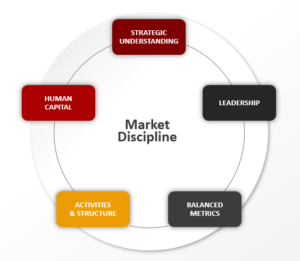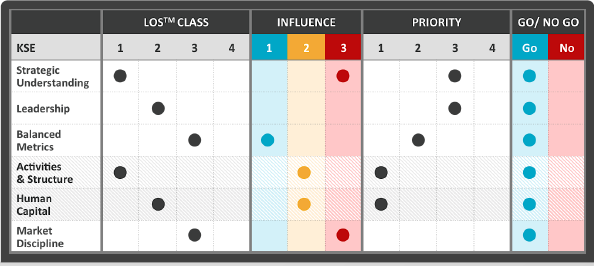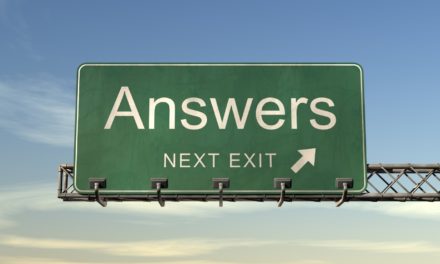HR is generally a participant with the executive team in establishing the business strategy. But HR’s strategic role goes  well beyond a team role in deciding the strategy. Execution is where most organizations struggle or fail, and HR can significantly impact execution.
well beyond a team role in deciding the strategy. Execution is where most organizations struggle or fail, and HR can significantly impact execution.
There are six Keys to Strategy Execution (KSEs) that are essential to optimize performance in any business. While HR is not singly responsible for all activities within each KSE, these provide an effectively targeted, strategic context for goal setting across all functions, including Human Resources. At first glance, it may be tempting to assign HR to only one KSE, Human Capital. But we recommend that HR build its expertise and involvement over time to eventually impact and support the company’s performance in all six. Here’s why: the alignment of all organization activities, from people to procedures, policies, budgets, work tasks, and more, is critical to the organization’s readiness and capacity to execute on the strategy. HR is uniquely positioned and skilled to provide support and initiatives to enable alignment. We’ll talk about each KSE now.
1. Strategic Understanding
How important do you believe it is for each employee, temporary, regular, part-time or full-time, to understand the company’s strategy, how he fits into the big picture, who the competitors are and how your company differentiates itself? Understanding this, being articulate about it outside work with family and friends, being able to act and perform in ways that maximize his contribution to that differentiation — this intimate knowledge is essential to fully engaging employee commitment and building employee performance. Even in companies where strategy is discussed often, it is typical that only 13% of employees will achieve this level of understanding. Leaders need to communicate often and in an engaging way, using stories and language easily understood by all workers, so that they can relate to it individually.
What is Strategy? If we ask 10 executives we’ll probably get 10 different answers. Let’s define it in actionable terms here. Your company’s strategy is the unique difference, its differentiation, that makes its customers buy from you rather than going to a competitor. Each employee should be able to explain who the company’s competitors are, what differentiates your company, and how his role contributes to that differentiation. Once each employee can answer each of these three questions fully and accurately, you’ll have achieved a strategic understanding in your workplace. HR’s goals related to this KSE can become clear through discussing questions such as these:
How can HR:
- ensure there are varied, interesting discussions and mention of the strategy?
- partner with leaders to actively involve employees in using the strategy as a guide to prioritizing their work, making job related decisions, finding new ways to contribute to strategic differentiation?
- help to infuse these discussions and activities with enthusiasm and excitement?
- build strategy into all aspects of employment beginning with recruitment?
2. Leadership
There are 3 dimensions of Leadership that significantly impact an organization’s effectiveness in executing its business strategy, including a Leader’s:
- credibility throughout the organization
- ability to prepare and move employees through change
- delivery of communication on a daily basis that effectively focuses the attention of employees on the organization’s strategy, and that is clear, meaningful and actionable
Credibility is required because in order to have certainty about what must be done and how, an employee must have confidence that leaders have set a direction that will provide a good future for the business and that they know what must be done short and long term to achieve it. Often-times, leadership credibility can be strengthened through effective leader communication about the strategy.
Strategy also provides a context for change. Change is usually needed in order to continually align and fine tune the organization’s alignment with that strategy. Leaders who make the connection for people, between changes and the strategy, through two-way communication, continuously build their credibility and employee commitment.
In addition, strategy needs to be adjusted or changed periodically in order to meet changing customer needs, competitors’ advances, technology change and other change that occurs in the business environment. Discussions about these changes are essential to ensure the continued understanding of the workforce.
Delivery of strategic communication on a daily basis that is interesting, varied, and that creates memorable employee exper
iences will also contribute to leadership credibility and build engagement.
In establishing its strategic goals for this KSE, HR might find the following questions useful. How can HR:
- help leaders to be consistent, clear and engaging in their messaging about the strategy?
- ensure the purpose, rationale and strategic impact of change are explained to employees in a way that is meaning for each individual?
- partner with leaders to engage in two-way strategy-focused dialogs with employees?
3. Balanced Metrics
Effective development, use and communication about an organization’s metrics can help keep employees focused on delivering the company’s unique differentiation. Metrics can be shaped to work as guides employees can use to prioritize daily tasks and activities, to make countless job-related decisions during the course of each day, to determine ways they can contribute to the unique value the
company provides to customers, and find ways to better align policies, systems, practices, projects and other activities.
Using both leading and lagging indicators is to your advantage in measuring performance for individuals, groups and the organization as a whole. Leading indicators can be used to spot problems and obstacles early, in time to minimize or prevent impact on customers or on financial metrics. Lagging indicators measure financial results. HR can partner with leaders to build a scorecard including an effective blend of (a limited number of) leading and lagging measures, and to establish routines for regular updates and problem-solving discussions with employees. To establish strategic goals supporting this KSE, the following discussion questions may work well.
How can HR partner with leaders to:
- identify and select a limited number of metrics, using both leading and lagging indicators, to use in monitoring and communication with the workforce?
- leverage existing meetings and systematize high employee involvement in discussing updates and problem solving based on use of metrics?
- help ensure the metrics chosen are ones that employees can understand, relate to, and act on?
4. Activities and Structure
Diagramming your business as a flow of value-adding activities is a powerful step toward building competitive advantage. The resulting diagram is your Value Chain, or your customized model of activities that deliver your valuable product or service for the market. This concept was first developed and introduced as a standard business management tool by Michael Porter in his 1985 best-seller, ‘Competitive Advantage: Creating and Sustaining Superior Performance’.
Alignment of your Value Chain enables you to deliver, with excellence, your company’s unique differentiation (aka your Value Proposition). For example, a recent article in Forbes, “Customer Service: What Southwest Knows And You Don’t (Hint: Being Nice Isn’t Enough)”, by Micah Solomon, described how Southwest Airlines aligned its organization around creating an exceptional customer experience for its clients. The story described a customer’s experience when his plane was late, causing him to miss his connecting flight – and when disembarking the plane, Southwest’s gate staff provided a connecting boarding pass to him, and to other affected passengers. Instead of rushing around under stress to find and book new connecting flights, he was able to go to his new departure gate. This simple sounding action could not have been accomplished by one caring gate keeper. To make this happen required that Southwest align its systems and its staff with the strategy.
Organization structure and culture must also be aligned to support the strategy. For example, a functional structure is efficient due to specialization. A product-aligned structure can be more effective in organizations where teamwork is essential to getting work done. In one organization, the strategy requires a culture of high employee involvement with decision making authority in the hands of front line employees. This works well when the value proposition is one of customer service and satisfaction, as trained employees ca
n make decisions to address customer needs and problems quickly. In another organization where work processes and methodologies are tightly governed and checked by regulatory agencies, a culture and structure designed to limit variation and centralize decision-making may work best.
HR does not need to have personal expertise in all of the functions of the Value Chain, in order to impact alignment and subsequently, strategic performance. Goal-setting for this KSE might be supported by discussing how HR can:
- enable discussions in each department, that identify new and existing activities that contribute the company’s unique value/deliver on the value proposition
- partner with leadership to involve employees in identifying needs for management support or changes in structure and culture that will empower employees to initiate action that contributes to the unique differentiation of the company
- facilitate discussions to map the Value Chain
5. Human Capital
Three critical dimensions of Human Capital management include:
- Targeted Training
- Knowledge Sharing
- Talent Management
We believe you’ll agree that these dimensions can have significant impact both short and long term on the organization’s success in executing on the strategy.
Targeted Training refers to training and development activities that are needed in order for employees to perform key work inherent in the strategy. This can include specific job competencies; new technical skills for product and service design, support and troubleshooting, internal business processes and systems; relationship building, problem solving, and project management; leadership skills and more.
Knowledge Sharing is currently recognized as essential for growing and/or changing organizations. A systematic approach that makes it quick and easy for employees to document and share knowledge i.e. what they learned in training, learnings from experience, success, mistakes, and networking — can save time when new people are getting up to speed, can shorten learning curves as people take on new responsibilities or projects, and can provide opportunities for visibility for those who are highly knowledgeable and/or respected as informal leaders.
Talent acquisition, succession planning and other Talent Management activities all enable continuity for the business. A company’s ability to find, attract, hire, develop and retain people whose skills, knowledge and interests align with their jobs and the business strategy, is key in building the value of its intellectual property and human capital. These intangibles impact the company’s ability achieve its strategy and its sustainability into the future.
HR is uniquely positioned as a function to make an especially strong impact on the business through this KSE. To continue to build its positive impact on the Human Capital KSE, HR might discuss with its team and its peers:
- what can be started, stopped, improved or changed in the Talent Management arena that would better equip the organization for the future, with the right people who have the right skills to deliver the strategy?
- what ”hygiene” work of Talent Management can be automated or outsourced to allow existing staff to focus on strategic activities?
- what Talent Management knowledge and skills need to be developed, hired or brought in through consultants, in order to improve the function’s alignment with the strategy?
6. Market Discipline
Throughout this article, we’ve continued to reinforce that a strong connection is needed between the organization and its strategy. Market Discipline is the term coined in books about strategy, referring to the decision that a business must make as to its differentiation or value proposition. Treacy and Wiersema’s three strategic disciplines are (1) operational excellence, (2) product leadership, and (3) customer intimacy. It is generally recognized that while a company needs to perform well in all three disciplines, it must choose just one of the three to do with excellence, as their differentiation.
To deliver on one discipline, with the whole organization aligned to the strategy, requires resources and
costs money. Can a company choose 2 or all 3 disciplines for differentiation? Let’s answer this question with some more questions, this time. Would a company be able to align its organization and its people to be both operationally excellent and provide product leadership? How much would operating cost be impacted? How would differing goals impact teamwork effectiveness, and work processes?
Perhaps HR could set a goal on this KSE, to open up a good discussion to reach agreement among the leadership team on the Market Discipline tradeoffs and choices.
We are convinced that now is the right time for HR to take and leverage its seat at the table to make its strategic impact. As businesses work to re-build and grow following years of economic adversity, it is now HR’s skills and expertise relative to critical “intangibles” that can be highly leveraged to make a difference, to build success for the organization both short and long term. To execute effectively reqires Market Discipline, Strategic Understanding, Leadership, Balanced Metrics, Activities and Structure and Human Capital, all strategically aligned and continuously improving. These KSEs are the pillars for successful execution and achievement of the business strategy. Is your H.R. organization ready? What does it need to do next?
If your HR function is one of the many who are evolving to achieve its strategic potential, the following prioritization and action planning tool may help.

To use this tool, review each KSE individually. As you read across, you’ll see the second column, LOS Class, refers to the results of completing our Line-of-Sight assessment. If you’re using this chart without having used this assessment tool, skip this column and go instead to Influence. How much influence does your HRteam have with each KSE’s set of decision makers? Rate your influence with 1 being high, 2 medium, 3 low.
Then evaluate the priority based on the business need for action on each KSE. Rate this 1-4, with 1 being high, 4 meaning the KSE work can wait longer. Then make your decisions on each KSE area to act (go) or not (no go), using the last column on the right. Then, develop your goals and action plans for the “go” items.
Latest posts by Rosanna Nadeau, PCLEC (see all)
- Is Quality Being Lost In Today’s Quest For Efficient Execution? - August 31, 2023
- What is HR’s Strategic Role? - August 24, 2023
- Agility: The Ability to Zig and Zag - August 23, 2023













Very in depth and thoughtful article